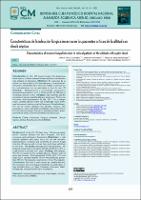Características de la infección fúngica invasiva en los pacientes críticos de la altitud con shock séptico
Related Resource(s)
http://cmhnaaa.org.pe/ojs/index.php/rcmhnaaa/article/view/1697Date
2023-02-14Author(s)
Tinoco Solórzano, Amilcar
Ortiz Ruiz, Guillermo
Montelongo, Felipe de Jesús
Granda Luna, Ignacio
Quispe Cornejo, Armin
Quispe Montero, Maricela
Metadata
Show full item recordAlternate title
Characteristics of invasive fungal infection in critical patients of the altitude with septic shock
Abstract
Introducción: En UCI, 19% tienen hongos, 23% desarrollan shock séptico. Cándida albicans el más frecuente. Antimicótico más utilizado es fluconazol. Objetivos: En residentes de la altitud con shock séptico (SS) describiremos: Características, evolución y sensibilidad de la infección fúngica invasiva (IFI) y los contrastaremos con los publicados a nivel del mar. El estudio: Retrospectivo y transversal. Analizamos hemocultivos de adultos con SS y IFIs en una UCI a 3,250 metros de altitud, durante 7 años. Hallazgos: 123 muestras. Las IFIs aumentaron 3.6 para candida albicans. Mujeres con 74 años fue frecuente. BGN representaron 52.88%, BGP 37.9% y hongos 9.22%. Cándida albicans 79.67% con sensibilidad mayor al 90% para Voriconazol, Anfotericina B y Fluconazol. Conclusiones: IFIs con SS fueron causadas por cándida albicans, IFIs aumentaron, existe adecuada sensibilidad a los antimicóticos En la altitud existe mayor frecuencia del sexo femenino, mayor promedio de edad y una buena sensibilidad al fluconazol. Background: In the ICU, 19% have fungi, 23% develop septic
shock. Candida albicans the most frequent. The most
commonly used antifungal is fluconazole. Objectives: In high
altitude residents with septic shock (SS) we will describe:
Characteristics, evolution and sensitivity of invasive fungal
infection (IFI) and we will contrast them with those published
at sea level. The study: Retrospective and transversal. We
analyzed blood cultures of adults with SS and IFIs in an ICU at
3,250 meters of altitude, for 7 years. Findings: 123 samples.
The IFIs increased 3.6 for candida albicans. Women with 74
years was frequent. BGN represented 52.88%, BGP 37.9% and
fungi 9.22%. Candida albicans 79.67% with sensitivity greater
than 90% for Voriconazole, Amphotericin B and Fluconazole.
Conclusions: IFIs with SS were caused by candida albicans,
IFIs increased, there is adequate sensitivity to antifungals. At
high altitudes there is a higher frequency of females, higher
average age, and good sensitivity to fluconazole.






